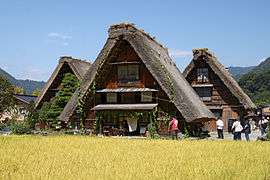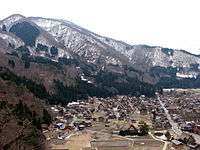Shirakawa, Gifu (village)
| Shirakawa 白川村 | |||
|---|---|---|---|
| Village | |||
 Shirakawa Village Hall | |||
| |||
 Location of Shirakawa in Gifu Prefecture | |||
 Shirakawa | |||
| Coordinates: 36°16′15.4″N 136°53′54.8″E / 36.270944°N 136.898556°ECoordinates: 36°16′15.4″N 136°53′54.8″E / 36.270944°N 136.898556°E | |||
| Country | Japan | ||
| Region | Chūbu | ||
| Prefecture | Gifu | ||
| District | Ōno | ||
| Government | |||
| • Mayor | Shigeru Narihara | ||
| Area | |||
| • Total | 356.64 km2 (137.70 sq mi) | ||
| Population (December 1, 2017) | |||
| • Total | 1,668 | ||
| • Density | 4.7/km2 (12/sq mi) | ||
| Time zone | UTC+9 (Japan Standard Time) | ||
| City symbols | |||
| - Tree | Siebold's beech | ||
| - Flower | Rhododendron | ||
| Phone number | 05769-6-1311 | ||
| Address | 517 Hatogaya, Shirakawa-mura, Ōno-gun, Gifu-ken501-5692 | ||
| Website | Official website (in Japanese) | ||

Shirakawa (白川村 Shirakawa-mura) is a village located in Ōno District, Gifu Prefecture, Japan. It is best known for being the site of Shirakawa-gō, a small, traditional village showcasing a building style known as gasshō-zukuri. Together with Gokayama in Nanto, Toyama, it is one of UNESCO's World Heritage Sites.
As of 1 December 2017, the village had an estimated population of 1,668 in 582 households and a population density of 4.7 persons per km2.[1] The total area of the village was 356.55 km2 (137.66 sq mi).
Geography
Shirakawa is a mountain village located in far northern Gifu Prefecture, bordering Ishikawa Prefecture and Toyama Prefecture on the Ryōhaku Mountains. Mount Hakusan is the highest elevation at 2,172 metres (7,126 ft). The village's area is 95.7% mountainous forests, and its steep places are characteristic. In between the mountains flows the Shō River, which continues to the north into Nanto, Toyama. Most of the population is in its river valley. Since the opening of Hida Tunnel, Shirakawa can be reached within 50 minutes from Takayama, Gifu compared to the earlier three hour drive, and only an hour to Nanto in Toyama.
Neighbouring municipalities
Climate
Shirakawa Village has a humid continental climate (Koppen Dfa). It features four distinct seasons with winter being its most recognised. Shirakawa is noted as one of the snowiest places in Japan. Yearly average snowfall amounts average out in excess of 10 meters (415.4") with snowbanks developing well over 2 meters tall. As a consequence of the frequent heavy snow, characteristically thick thatched roofed gasshō-zukuri (合掌造り) houses were created. With the Hakusan National Park mountain ranges as a background, these sites are major tourist attractions.
| Climate data for Shirakawa, Japan (1981–2010) | |||||||||||||
|---|---|---|---|---|---|---|---|---|---|---|---|---|---|
| Month | Jan | Feb | Mar | Apr | May | Jun | Jul | Aug | Sep | Oct | Nov | Dec | Year |
| Average high °C (°F) | 2.9 (37.2) |
3.5 (38.3) |
7.8 (46) |
15.6 (60.1) |
21.4 (70.5) |
24.7 (76.5) |
27.9 (82.2) |
29.6 (85.3) |
24.8 (76.6) |
18.9 (66) |
12.7 (54.9) |
6.0 (42.8) |
16.3 (61.3) |
| Daily mean °C (°F) | −1.1 (30) |
−0.9 (30.4) |
2.2 (36) |
8.8 (47.8) |
14.6 (58.3) |
18.7 (65.7) |
22.4 (72.3) |
23.5 (74.3) |
19.1 (66.4) |
12.7 (54.9) |
6.8 (44.2) |
1.6 (34.9) |
10.7 (51.3) |
| Average low °C (°F) | −4.7 (23.5) |
−5.2 (22.6) |
−2.5 (27.5) |
2.7 (36.9) |
8.3 (46.9) |
13.8 (56.8) |
18.1 (64.6) |
19.0 (66.2) |
15.0 (59) |
8.2 (46.8) |
2.3 (36.1) |
−2.0 (28.4) |
6.1 (43) |
| Average precipitation mm (inches) | 275.1 (10.831) |
213.3 (8.398) |
195.0 (7.677) |
143.1 (5.634) |
139.9 (5.508) |
203.5 (8.012) |
280.4 (11.039) |
165.1 (6.5) |
223.1 (8.783) |
148.3 (5.839) |
200.5 (7.894) |
249.8 (9.835) |
2,437.1 (95.95) |
| Average snowfall cm (inches) | 356 (140.2) |
271 (106.7) |
162 (63.8) |
23 (9.1) |
1 (0.4) |
0 (0) |
0 (0) |
0 (0) |
0 (0) |
0 (0) |
23 (9.1) |
212 (83.5) |
1,055 (415.4) |
| Mean monthly sunshine hours | 54.7 | 76.2 | 116.0 | 163.3 | 177.8 | 145.6 | 148.3 | 171.6 | 118.0 | 112.9 | 83.4 | 61.6 | 1,426.7 |
| Source: Japan Meteorological Agency[2] | |||||||||||||
Demographics
Per Japanese census data,[3] the population of Shirakawa has decreased over the past 40 years.
| Census Year | Population |
|---|---|
| 1970 | 2,525 |
| 1980 | 2,132 |
| 1990 | 1,892 |
| 2000 | 2,151 |
| 2010 | 1,733 |
History
The area around Shirakawa was part of traditional Hida Province. During the post-Meiji restoration cadastral reforms, the area was organised into Ōno District, Gifu. The village of Shirakawa was formed on July 1, 1897 with the establishment of the modern municipalities system.
Economy
The local economy is dominated strongly by seasonal tourism. Due to the income from the tourists who came to see the gassho-zukuri villages, the financial condition of the village has been greatly improved, and tourist traffic increased further once the village became a UNESCO site. However, the increasing number of visitors has resulted in damage to the area from pollution, and by local inhabitants their homes into hostels, gift shops and parking lots, which in turn has endangered its World Heritage status. There is also a fear growing that the change to catering to tourists will harm the charm of the area's simplicity and fundamental Japanese scenery.
Education
Shirakawa has one combined public elementary/junior high school operated by the village government. The town village does not have a high school.
Transportation
Railway
- Shirakawa village does not have any passenger railway service.
Highway
Sister city relations

Local attractions
- The Historic Villages of Shirakawa-gō and Gokayama are designated UNESCO World Heritage sites
- Wadake Home—the largest gasshō-zukuri in the area
- Shirakawa-gō Hirase Onsen (designated as a "national recuperation onsen")
- Miboro dam, Lake Miboro
- Hida Tunnel
- Hakusan Rindō (hiking path)
- Amau Pass (天生峠 Amau tōge), famous for its fall colors; 30 minutes away by foot is the Kōsō wetlands, also famous
- Shirakawa Hachiman Shrine, where every October 14–15, the Doburoku Festival, famous for its Nigorizake is held
Gallery
 Ogimachi village in Shirakawa-gō
Ogimachi village in Shirakawa-gō- Shirakawa
 Traditional housing in Shirakawa-gō
Traditional housing in Shirakawa-gō Shirakawa
Shirakawa
In popular culture
- The village of Hinamizawa in Higurashi no Naku Koro ni (ひぐらしのなく頃に, lit. When the Cicadas Cry), a popular Japanese murder mystery dōjin soft visual novel series, is heavily based on Shirakawa, with many local landmarks clearly recognizable.
- In Gosho Aoyama's Detective Conan, Onizawa village from episodes 348-349, is modeled from real life Shirakawa.
- The final issue of Uncanny X-Force Vol. 1 opens with Wolverine visiting Shirakawa.
- The village of Minasato in the kemono visual novel Morenatsu (summer vacation) is based heavily off of Shirakawa.
See also
References
External links
| Wikimedia Commons has media related to Shirakawa, Gifu. |
| Wikivoyage has a travel guide for Shirakawa-go. |
- Shirakawa official website (in Japanese) (some English content)
- UNESCO entry on Shirakawa-go and Gokayama
- Information related to Shirakawa-go on the official Gifu tourism website
- shirakawa-go.gr